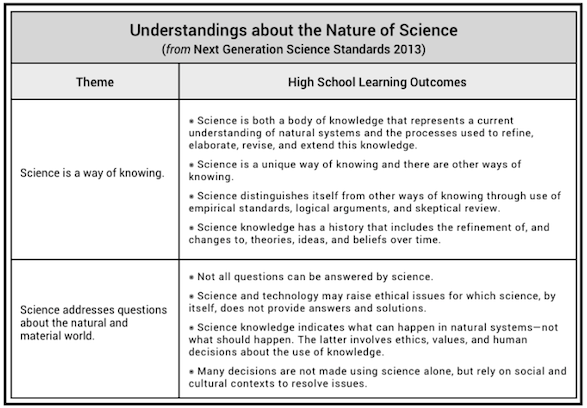
“[S]cience is fundamentally a social enterprise,” write the authors of the U.S. National Research Council 2011 Framework for K-12 Science Education.
As I described last week, the framework is the basis for the Next Generation Science Standards (NGSS), and both are bolstered with a good measure of systems thinking — including this type of reflection on the role of science itself. In the lingo adopted by the framework and standards, such science-and-society reflections are called understandings about “the nature of science.”
The NGSS nature of science matrix includes eight understandings or themes, along with school-level learning objectives for each of the eight (in Appendix H, pdf). To illustrate, I created the table at top with two of the themes and their associated high school learning objectives. These understandings constitute, in effect, an attempt to delineate the boundaries of scientific ways of doing and knowing.
Whether these learning objectives serve to well and sufficiently characterize the nature of science is of course a matter of opinion. Some critics have emerged, but I’m quite impressed with inclusion of these understandings.
My questions are more about the lack of a clear relationship between the nature of science as a topic area and the three primary topic areas or dimensions: practices, disciplinary core ideas, and crosscutting concepts. These three are represented in the logo and icon, which presents a triangular weaving that is more-or-less like the diagram on the left below, only more colorful and design-y. In this icon, the nature of science is not depicted.
I’m not the only one left wondering what happened. From the public feedback, as described in the framework’s Appendix A: “Many of those who provided comments thought that the ‘nature of science’ needed to be made an explicit topic or idea.”
Suppose that, following this recommendation, the nature of science were considered more explicitly, how might it be positioned in relation to the three dimensions? Below on the right is one suggestion for re-conceiving the icon and clarifying the nature of science as the boundary.
Here’s my rationale, in sum: There is something called science. Science includes ways of both doing and knowing. Scientific ways of doing and knowing, versus other ways, are delineated by something called here the nature of science. Different people will inevitably have different opinions on how to characterize this boundary. But not clarifying that the nature of science in fact constitutes the boundary seems like a missed opportunity.


Update: I got in touch with Cary Sneider, who is Associate Research Professor at Portland State University and was a writing team leader on the Next Generation Science Standards.
Here’s Cary’s response (reprinted with permission):
Hi, Howard, Nice to meet you! I appreciate your thoughtful blog about the nature of science and the NGSS. Here’s the backstory. In developing the NGSS we relied on the Framework as a blueprint. The Framework did not include “scientific inquiry” or “nature of science” and instead focused on “practices of science and engineering” which was an attempt to represent the way actual scientists and engineers work, rather than the extensive literature that has been developed around the more abstract ideas of “nature of science” by Norm Lederman and others.
However, the National Science Teachers’ Association objected that those ideas about the nature of science are important and should be included; so in fact they were, under the category of “crosscutting concepts,” along with other ideas about the science, technology, and society, and the seven specific crosscutting concepts from the Framework. So it’s a bit of a patchwork quilt.
The real advantage of the NGSS is that it limits the number of standard on which students will be tested. It is, after all, an assessment framework, not a curriculum scope and sequence chart. Second, it combines practices and core ideas, so it is not possible to teach and assess science as a collection of facts. Third, it elevates engineering design to the same level as scientific inquiry, which emphasizes practical applications of science, not just knowledge for knowledge sake.
The quotes you picked out also illustrate that science teachers no longer need to be confined to pure science. Environmental, economic, historical, and ethical issues can and should be discussed in science class, and can well bleed over into English and social studies classes.
Among other projects I’ve co-authored a book called STEM Lesson Essentials, which emphasize the value of integrating the four STEM subjects. I’m happy to extend that to art as well, and note that one of the chapters is about STREAMS, which also include reading, English and art.